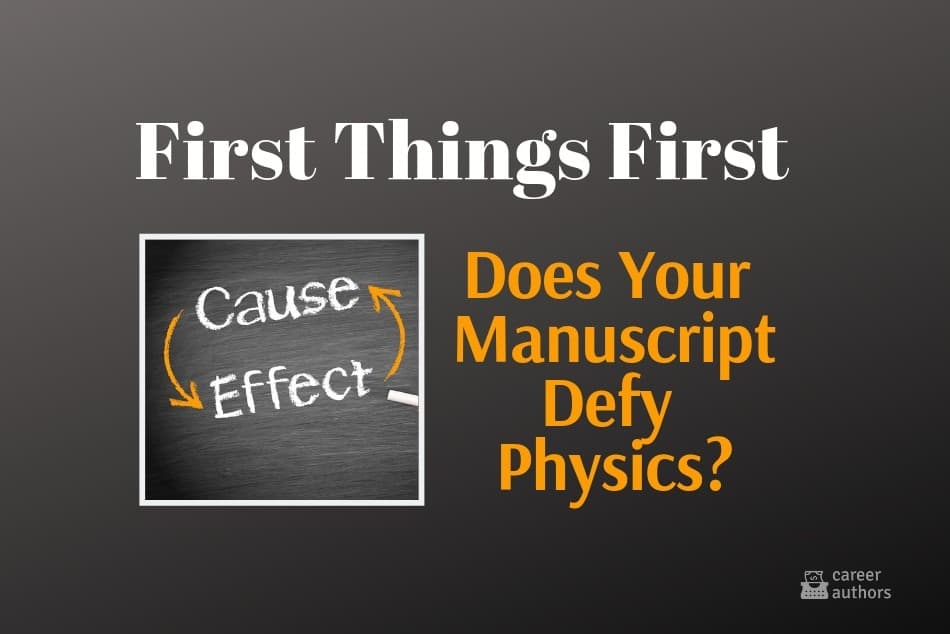Here’s a quiz for you. I’ll show you two excerpts, each from an early version of my new book.
There’s one big thing wrong in each of them. And it’s the same thing. (I’m nervous about this, imagining a whole list of things you’ll find, but for the sake of Career Authors, I’m going for it.).
So. This one is a snippet from a scene that takes place in a courtroom, where’s there’s just been a Perry Mason–worthy revelation. A main character, chief of staff Rachel North, is in the audience. She’s sitting next to her boss, Senate President Tom Rafferty.
What’s wrong with this excerpt?
The judge banged some object that wasn’t a gavel, maybe a block of wood. He didn’t yell order, order, like they did on TV. But his intent was clear. When a fidgety hush fell over the courtroom, the judge waited. One beat, two.
“One more outburst,” he said. “One. And I will close this courtroom. Understood? And you will all be removed.”
Fine with me, I thought. The fewer people who heard this stuff the better. I hoped there were no more cats in the bag. Several of the reporters had raced out of the room anyway, the courtroom door banging shut behind them. I mentally shook my head. Apparently serial adultery was bigger news than murder.
I’ll pause while you read it again. Do you see the error?
Exactly the same pitfall
Look at another example of exactly the same pitfall. It’s in an earlier part of the scene, where Rachel and the senator are going into the courtroom. Or trying to. (And here’s a clue: It’s not about commas.)
“Is your wife a murderer, Senator?” “Why did she do it?” “Why would Nina kill Danielle Zander?” “Were you having an affair?” “Are you going to resign?”
“No comment no comment, the senator has no comment,” I repeated. I was a robot, a talking robot, but I felt Tom Rafferty silent and seething behind me. We made it to the tall wooden courtroom doors of room 226. I pulled one of the metal door handles. Nothing. Tried the other one. Nothing. And again. Nothing. Locked.
“No comment no comment no comment,” I said as I kept trying, rattling the curved handles with one hand, knocking like crazy with the other. Tom and I were trapped here, sandwiched between the closed doors and the insistent reporters. Not a good battle strategy.
Cause and effect
Here’s the answer: cause and effect. Parts of each scene are in the wrong order. Some manuscripts defy the laws of physics, with writers putting the reaction first, then the action.
See? A reaction must come after an action. It’s the “effect and cause” pitfall, like saying:
“What was that?” he yelped. He leaped from his chair. The doorbell rang.
That’s obviously wrong, right? The doorbell has to ring first, then the person reacts.
She paused, terrified. She heard footsteps behind her.
Hmm. She stopped because of the footsteps. Most often, your sentences should be written in the order the action happens—Action, reaction.
Confusion, not suspense
Sometimes, writers use a reverse cause and effect thinking it creates suspense.
She paused. Waited. Listened again. Closed her eyes to try to hear more clearly. Was she wrong? Were those footsteps?
You’ve read paragraphs like that, right? But a reader envisioning this scene has no idea what’s going on. Remember, confusion does not equal suspense. It equals confusion.
You could say: She paused, terrified. She’d heard footsteps behind her.
But why would you do that?
So look at the first excerpt again, with the cause-and-effect changed and bolded. (Not bolded and changed.)
“One more outburst,” he said. “One. And you will all be removed. Then I will close this courtroom. Understood?” (Because how can you close the courtroom, and then remove the people?)
Fine with me, I thought. The fewer people who heard this stuff the better. I hoped there were no more cats in the bag. Several of the reporters had raced out of the room anyway, the courtroom door banging shut behind them. I mentally shook my head. Apparently serial adultery was bigger news than murder.
Bonus: increase the conflict
And in the other excerpt, if we start with the reporter questions (it’s mid-scene), and sprinkle them through, we know what Rachel’s reacting to, both physically and emotionally. We know “what these reporters were asking.” And the conflict is also increased.
“Let’s do this,” I muttered. I lifted my chin and powered ahead, carving a path for the senator, unstoppably determined, as if I were his personal fullback. What these reporters were asking, what they were demanding, what they were thinking, was outrageous. Insensitive. Demeaning. Disrespectful. And, though I hated myself for it, exactly what I wanted to know myself.
“Were you having an affair?”
“No comment no comment, the senator has no comment,” I repeated. I was a robot, a talking robot, but I felt Tom Rafferty silent and seething behind me. We made it to the tall wooden courtroom doors of room 226. I pulled one of the metal door handles. Nothing. Tried the other one. Nothing. And again. Nothing. Locked.
“Are you going to resign?”
“No comment no comment no comment,” I said as I kept trying, rattling the curved handles with one hand, knocking like crazy with the other. Tom and I were trapped here, sandwiched between the closed doors and the insistent reporters. Not a good battle strategy.
First things first
Cause and effect. First things first. Action, reaction. This, then that.
This is also part of keeping a clear timeline so your readers don’t get lost.
Have you noticed cause and effect going awry in books? How about in your own manuscript? Come chat on the Career Authors Facebook page.
And then, get writing.





